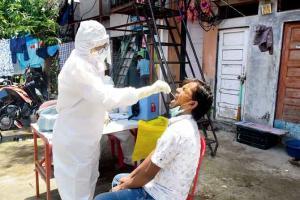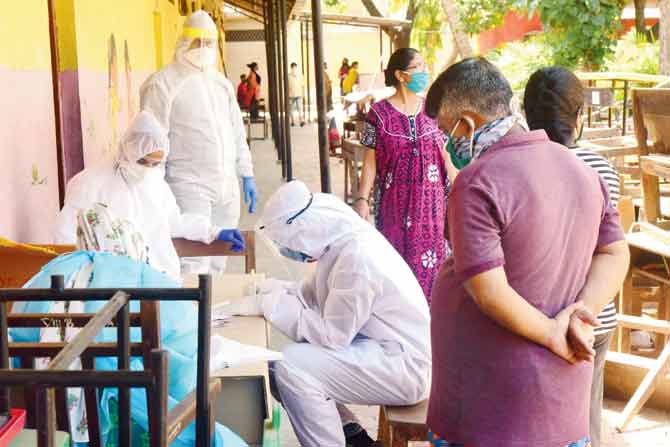COVID Task Force says a combination of non-invasive intervention like high-flow oxygen supply and drugs like remdesivir and tocilizumab has helped bring down daily death toll in Mumbai

A person being tested for COVID-19 at Dharavi. PIC/Suresh Karkera
After recording 120 COVID-related deaths in a single day on June 24, Mumbai's death toll has seen a gradual dip and in July, the daily count of deaths has consistently been below 75. While experts may have a different reasoning for the drop in the mortality rate, they unanimously feel that improvement in treatment protocols has helped reduce the number of critical patients who need a ventilator.
ADVERTISEMENT
Members of the COVID Task Force said that the condition of patients with severe symptoms is improving with the use of non-invasive ventilation techniques including high flow nasal oxygen supply (HFNO) and the BiPAP machine (delivers pressured air through a mask). Experts feel that a balance between non-invasive support and drugs like Remdesivir and Tocilizumab has also helped patients recover.
'Our understanding has grown'
Dr Kedar Toraskar, director of critical care at Wockhardt Hospital, as well as a member of the COVID task force said, "The strategy is to obviate ventilation by using non-invasive support. Over the past three months, our understanding of the pathology of the disease has grown and we have more experience. The combination of medication and HFNO that is used more liberally now is leading to fewer patients requiring intubation, and thus reducing mortality among COVID patients."
Dr Toraskar pointed out the importance of timing when medication is given to the patient. "We have been able to fine tune the right drug to give and the right patient. For instance, if Tocilizumab is given too early, it can lead to secondary bacterial and fungal infections. We also saw that low dose steroids used in the inflammatory phase is working well and timing is very important because using it too early will lead to more harm," said Dr Toraskar.
 Doctors and health workers test quarantined people at the Transit Camp Municipal School in Dharavi. Pic/Suresh Karkera
Doctors and health workers test quarantined people at the Transit Camp Municipal School in Dharavi. Pic/Suresh Karkera
Dr Shashank Joshi, another member of the COVID task force and Endocrinologist with Lilavati Hospital, pointed out that there is a gap of 80 per cent in the projected requirement of ventilators and the actual need. "Many patients are doing better with the use of non-invasive ventilators and the need has now shifted to use of high flow nasal oxygen supply," he said.
Dr Neelam Andrade who is heading the COVID Care Centre at NESCO exhibition grounds in Goregaon, has seen positive results of using the HFNO and biPAP machine and fewer transfers of patients requiring ventilation. "Earlier, we transferred 5-6 patients a day to ICU facilities for a ventilator. But in the past few weeks, we have only transferred a couple of patients every 2-3 days," she said.
Similarly, at the COVID centre at NSCI Dome in Worli, Dr Mufazzal Lakdawala said so far, only one patient has been put on ventilator. "More than 80-85 per cent of the critical patients we get are being treated with non-invasive ventilation," he said.
'More treatment options available'
Dr Gautam Bhansali of the Bombay Hospital, laid emphasis on the availability of more treatment options. "A month ago, patients would come with mild symptoms and within a few hours, their condition would deteriorate. Now with more treatment options, early intervention is possible," he said. He added that at Bombay Hospital, around 80 patients are admitted on a daily basis and while earlier, 10-15 per cent of them would need a ventilator, now only 2-5 per cent require them.
Another task force member and Senior Intensivist with Fortis Hospital, Dr Rahul Pandit, felt that the technique of nursing patients in a prone position (lying on the belly) has worked well. "The general trend indicates that patients who were earlier going on ventilators are now doing better with HFNO while in a prone position. However, this needs to be proven in a study," he said.
Catch up on all the latest Mumbai news, crime news, current affairs, and a complete guide from food to things to do and events across Mumbai. Also download the new mid-day Android and iOS apps to get latest updates.
Mid-Day is now on Telegram. Click here to join our channel (@middayinfomedialtd) and stay updated with the latest news
 Subscribe today by clicking the link and stay updated with the latest news!" Click here!
Subscribe today by clicking the link and stay updated with the latest news!" Click here!






